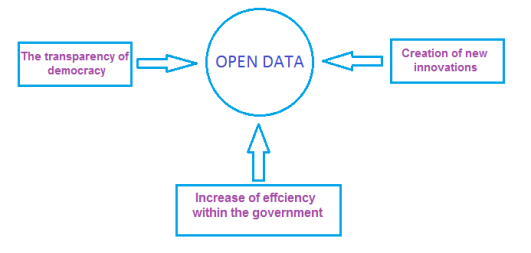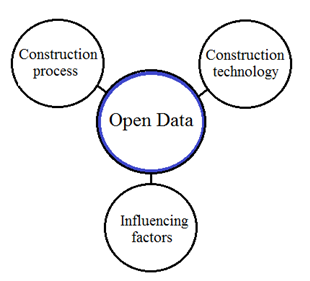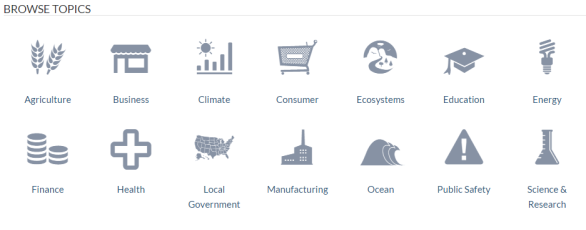Open data is information that anyone is free to use and distribute. Only one requirement is valid: to indicate the source of data and distribute it under the same conditions as the original. Open data, in particular the open government data is still a huge untapped resource. This article explains what the open data is, compares databases in different countries and discusses the possibility of using open dataset as an additional source of information about any building. This is also explains how modern database can be used in the aims to simplify, speed up and improve the current approach to data collection process. And at the same time, how the use of open data sources in this case can be successfully applied to the building or construction processes.
Keywords: Open data, dataset, open source, transparency, innovation, government.
The current state of development of the society and the economy in the information society operation and development democracy highlights up the issue of openness and accessibility of information. In this regard, there was such a thing as open data, which are widely used by both politicians and the general people. [1–5]
Open data is the concept that reflects the idea that all tax-paid data should be free and accessible to everyone without such limitations as copyright, patent and other control mechanisms. Open data is often focused on non-textual materialsuch asmaps,genomes,chemical compounds, mathematical and scientific formulae, medical data and practice, bioscience and biodiversity. Access to data as well as their subsequent use is controlled by public and private organizations. The main required for open data placement is the free and chargeless use for everyone. Including right to spread, copy, publish and combine with other information. [5–12]
The concept and the background
Open data is the concept that reflects the idea that all tax-paid data should be free and accessible to everyone without such limitations as copyright, patent and other control mechanisms. Open data is often focused on non-textual material such as maps, genomes, chemical compounds, mathematical and scientific formulae, medical data and practice, bioscience and biodiversity. Access to data as well as their subsequent use is controlled by public and private organizations. The main requirement for open data placement is the free and chargeless use for everyone, including right to spread, copy, publish and combine with other information.
In principle, open data is not a new phenomenon, it has long existed in various forms. Open source and free licenses were not five, not ten years ago, but much earlier. The first steps towards the public available data were made in the 50s of the last century. Since July 1, 1957 to December 31, 1958, the geophysical observations and studies of a single method were conducted around the globe — this event is conventionally called the International Geophysical Year (IGY). Then the World Data Centre for storing data (resulting from activities carried out in the framework of the International Geophysical Year) was formed by International Council for Science. In 1958, NASA's legislature project was designed to ensure the broad dissemination of information. NASA has a long history of storing huge amounts of scientific data which is laid out in the public domain on the Internet, it is necessary to emphasize that the Agency has accumulated a huge amount of scientific data. But everything went not from the officials and the state, but from people who engaged this much earlier. Gradually, it has acquired such a mass character, that it was no matter if state opens data or not — somehow, it has already been learned to extract. In the United States before the appearance of data.gov, the Sunlight Labs and Knights Foundation were existed, it extracted data from the reports of Congress, converted into PDF-files or excel-files, excel-file is loaded into the database, and then was converted in the.CSV.
At its best, open data creates a culture of cooperative approach to work, which is enabled by the social and technological development of the Internet. In addition it would force us to think about how we are going to live in the middle of the web era in the future, and how to utilize the data we produced together. Three ideas of open data are shown in Fig 1.

Fig 1. Three ideas of open data
Open data as a way to the “freedom” of information
The concept of open data means to increase the transparency of authorities, the formation of market for new applications and services, improving investment climate. Over the last decade the issue about implementation of the open data idea, its development, benefits, use and distribution has been widely discussed on the international forums and conferences in Europe. As a result, there was set three different goals to aim: the transparency of democracy and administration, creation of new innovation and the increase of effciency within the government. [13,14]
Open data has long been used in almost all existing areas of business, medicine, education, politics, free transport, finance, statistics, geography, federal agencies, meteorology, science.
Let's start with transparency. Through projects such as the Finnish «tax tree» or the British «what are my money», you will know how the government spends your taxes. For example, thanks to open data in Canada it became possible to manage to stop fraud, tax breaks for charity a sum of 3.2 billion dollars. Danish “husetsweb.dk” site help to improve the energy efficiency of your home, perform financial planning and to find builders to do the job. It uses inventory information and information about government subsidies, as well as local companies register. Developers of “Google Translate” improve the quality of service, teaching translation algorithms on a huge volume of documents of the European Union, which are available in all European languages.
Opening the data begins with evaluating the organization’s own information resources. This is not a fast process, depending on the size and nature of the organization. However, not everything has to be done immediately. The opening process could proceed step by step, starting from the easier data and gradually moving on to more complex data sets. During the data analysis, organizations may come across data that they had no knowledge about or did not know how to use. The organization can decide on their own how to utilize the information they have. To make it easier to use, after the inventory, all data should be converted into machine-readable format. Nowadays, more and more often, data is applied to the Internet and mobile applications. These applications allow users to access certain information without browsing the Internet. Of course, that way offers extra value.
What is important, organizations, which are offering their own data to be distributed, support the emergence of a truly useful service. Therefore, opening data is not a goal, instead it is a means of achieving the aim, and producing services is what is needed to accomplish by opening data. The most common wish is that the process would bring modern, creative and interesting uses of data, services that are usable and satisfy the needs of the public. When creating public data, it is quite essential to make the data as accessible and understandable as possible and to reach the users interested in that particular data. Accessibility can be technically improved by linked data, optimizing the results of search engines and adding the data to the largest data catalogues known to programmers.
Of course, the development of open data is gaining momentum also in the area of construction engineering.
Open data in civil and construction engineering
It is well-known, that construction is the largest industrial sector in the production and economic activity of the state. It includes not only all the organizational, survey, design, construction, installation and commissioning work associated with the creation, alteration or demolition of the object, but also the interaction with the competent authorities in the issue of production of such works. That is why the existence of open data is so important to resolve production issues and processes. [15]

Fig 2. Three parts of open data about construction process
Conventionally, all data associated with the building in general can be divided into three parts (Fig.2). Open data in construction process includes information about such inalienable parts as permit, design, investment, stages of building, etc. Construction technology involves data about building or construction equipment, use of new technologies,implementing research data, information about building materials and resources. Influencing factors include everything which connected with weather patterns, meteorologyand such natural factors as: hydrology, lay of land, atmospheric temperature, rainfall and water vapor, wind speed and airflow direction, ice, soil conditions and others. [16]
The issue of open data in the construction industry causes a lively interest in the whole world. According to the global ranking, prepared by the Open Knowledge Foundation to the summit of G8 in Northern Ireland, which took place June 17, 2013, the first line is occupied by the United States and United Kingdom. Russia, unfortunately, takes last place among the countries of the «Group of Eight» on the level of disclosure of information in the form of open data.Active development in this direction is in Germany and Finland. [20]
The most popular and common data associated with the construction are the following types of data:
Hydrology, ecology
Geodesy and topography
Certificates and licenses
Permits and orders for the construction
Information about the builder and contractor
What is important to note about open data
Nowadays, there are special building and construction commissions which develop and regulate the building industry. One of the main parts of their activities is the development of such policies of providing of open data which would provide complete and accurate information and at the same time does not violate the laws of confidentiality. At the moment, the free information in that area includes:
a register of licensees and building certifiers
a register of owner builder permits issued
a register of Authorized Nominating Authorities and adjudicators, and the results of adjudication decisions
The information and data that may violate privacy laws on commercial confidentiality, integrity and security:
insurance policy number,
the owner’s name
the builder’s name and license number
the site address
the type of work insured
the value of work and the policy commencement and expiry date
Therefore, the release of such data requires careful preparation, processing and compliance with the law.
Open data in Russian building industry
The largest portal of open data in Russia, data.gov.ru, contains the great resource of open information in civil and construction industry. There can be found the following dataset: information about road construction financing, inspection of developer’s plans, information about the developer’s fund raising, different quarterly reports, data about major construction work, commissions exercising state monitoring, the inspection result of the estimated cost and also information about vacant real estate. [17]
As an example it is possible to consider Russian open data portal data.gov.ru. It is very easy to use system. All is needed is to select a section and download the required document.
Open data in Europe
European open data portals aims to improve access to and increase the importance of open data, and will be responsible for the entire chain from data collection to the conditions and opportunities for their future use.
Nowadays, the first line in Europe is occupied by the United Kingdom. Finland and Germany have active development in this direction too.
The European Union is interested in creating a truly digital single market will reduce entry barriers to the industry of big data, allowing everyone to easily create versatile solutions for the European Union in the field of information and communication technologies. The European portal for open data was recently launched (https://open-data.europa.eu/en/data/). The goal of the portal is show the benefits of open data which the government agencies are providing and facilitate its continued use. European Data Portal developed by the European Commission with the support of Capgemini, INTRASOFT International, Fraunhofer Fokus, Con Terra, Sogeti, Institute of open data, Time.Lex and the University of Southampton.
Next part tells about most popular and good examples of open data portals all around the world. Following countries are the leaders in the field of open data.
Canada
Another example of the graphical representation of the open data in other countries is, for example, an interactive map of the Canadian city of Edmond (Fig 3). On the map there are special boxes by clicking on that it is easy to find out information about road construction in a particular place. For clarity, in the third figure it is possible to see how it works in general. In the pop-up window appear such data as: start year, project location, project limits, construction type, construction supervisor, project status and also phone numbers and some information about construction ward.

Fig 3. Interactive map of Edmond
United Kingdom
The most frequently used open data portal in UK is the Data.gov.uk (Opennig up Government). Website address is https://data.gov.uk/. Open Data portal of the United Kingdom was launched in private beta in September, 2009. The official launch of the portal was held in January 2010. Many different kinds of data can be found there. For example, environment, mapping, health etc. Many leading agencies and offices are involved in the process of providing information for placing it in the website. Now there are more than 9 thousands data sets.
Data.gov.uk project success is connected with a direct interest of the highest governing circles in disclosure and re-use of public data.
In June 2012 the Cabinet of Ministers and the Commission on transparency presented Open Data White Paper — it's a great document, which describes the current situation with the development of open data, organizational moments and future plans. The main idea is to create an infrastructure of access, establish the trust relationship with the community to use the data for the benefit of everyone.
The first projects that are based on open data in the United Kingdom:
Planning Alerts — an application that sends alerts if something is constructed or subjected to redevelopment in the area of residence. The UK is now closed, but it works in Australia. In Britain, a new project on the openness of municipalities is launched — OpenlyLocal
FillThatHole — “plug this hole”, the application and the site to collect complaints about potholes on the UK roads
United States of America
The main USA data portal is Data.gov (http://www.data.gov/). This portal was launched in 2009 at the initiative of the Barak Obama administration for the collection and publication of data of various state departments to further use in projects of physical and legal entities. Then President Obama said that the opening of government data is able to spur the development of new start-ups. Currently Data.gov offers more than 70 thousands datasets provided by 174 government departments and agencies. The interface is shown in a Fig 4.

Fig 4. The interface of the Data.gov
USA also has great data portal “Geoplatform” (http://www.geoplatform.gov/) which provides a large amount of useful information about climate, geology and at the same time has an interactive maps. Also, the National Geospatial-Intelligence Agency published the information (including maps) about infrastructure and geographical features of the area, including bridges, roads, railway tunnels, canals and rivers.
Finland
Over the past few years, the pace of development and implementation of open data in Finland increased significantly. This is connected not only with the active use of Internet and multimedia resources, but also with understanding the need of creating new and innovative solutions to the many social and economic problems. For example, The Ministry of Education and Culture has launched the Open Science and Research Initiative, for the promotion of information availability and open science for years 2014–2017. The Initiative will promote the reliability, openness and societal impact of science and research. The aim is to provide researchers with practical knowledge in how they as individuals can implement open data. The goal is that by 2017, Finland will become a leading country in the openness of science and research.
It is well known, that the good statistical office has always been in Helsinki, and now the city has reached a new level — all the data was published in the open access. Helsinki attracted neighboring towns to the collection and publication of data, as well as set a new competition format for developers. If somebody is interested in some information about Helsinki, the capital of Finland, it is likely, it will not be difficult to find. For more than a century, the city has been collecting data about population, employment, construction, and other things related to the urban environment. Today, thanks to the organization of City of Helsinki Urban Facts, the information is stored online and is available free for everyone. However, there was one problem — Helsinki is the largest city in Finland, but not the only one. Helsinki is the part of so-called metropolitan area, which consists of more than a dozen cities with a total population of almost 1,5 million residents. Therefore, if we have data only about Helsinki, we only have a part of the picture.
To solve this problem, Helsinki merged with three neighboring towns. The initiative is called Helsinki Region Infoshare and aims to become a hub of all these nearby towns. But that is not all. At the same time as data has become regional, they has become truly «open». In The site Helsinki Region Infoshare all the data is published in formats with which developers, researchers and journalists could work conveniently, analyze them and create useful applications on the basis of that information. For four years of working of that initiative, more than 1000 machine-readable data sets have been published from noise road traffic map and snow plows movement in real-time to a database of corporate taxes. Helsinki became the leader among open cities. The concept is the fact that many good things can come from the collection, standardization and free publication of urban data, brought in the European Commission's prize for innovation in public administration. In addition to creating the transparency in government, the initiative fueled many developers who create applications based on the data.
Another grate portal that has to be mentioned is the «Paikkatietoikkuna». Web address is http://www.paikkatietoikkuna.fi/web/fi. It is a public and free geoportal that contains geographic information about Finland and the rest of the world. Firstly, the map could be shown in three different styles: topographic, ortophotos and background map. The point is that the interactive map is divided into levels and layers. The Paikkatietoikkuna maps have hundreds items and elements which can be enabled or disabled. Therefore, it is possible to create your own map with information that will be useful and convenient for the particular user. The Paikkatietoikkuna stores data about such different areas as: buildings, administrative units, hydrography, traffic, transport networks, government services, human health and safety, population, surveying, natural risk zones and many others.
How open data can be used in civil engineering projects
The greatest open data source is Maanmittauslaitos (NLS). In this portal it is possible to download the 3D model of relief and then use it in different 3D modeling softwares. The process is very simple. It is needed follow the interactive map link, then select the specific area on the map, chose necessary options and send the request. After few minutes the file will be received on e-mail. For example it is possible to get the big special document where the many terrain points will be shown with its coordinates and heights. It lets to import point cloud directly into the information 3D modeling softwares. This is very useful system which allows to make 3D models much faster more precisely.
Conclusion
The advent of open data has allowed to simplify the solution of some problems related to varying human activities. Regardless of industry, the concept of open data has become one of the most rapidly developing and widely discussed in Europe and in the whole world over the past few years. In this issue, there are still so many niches for research discussions, and most importantly, for the development. This article tried to cover as much information as possible about the development of open data in Europe and in the world, about the importance of the implementation of this global project, also about plans and prospects.
The idea of open data, together with the modern technologies opens a big gate on the way to the Freedom of Information, and this is something what 100 years ago no one could dream of, and it is available to everyone now.
References:
- Poikola A., Kola P., Hintikka K. A. Public data. (2011) pp. 11–73.
- Sergeeva I. I., Sergeeva E. P., Smagina I. V. Open data in Russia: results and prospects (2013) Vestnik orelgiet, 1(7), pp.29a-32.
- Ministry of Agriculture and Forestry, Location: the Unifying Factor, Finnish National Spatial Data Strategy 2010–2015 (2011), pp. 3–21.
- Volkov A., Reingold L., Open data: problems and solutions (2014) Prikladnaya informatika, 3(51) pp. 5–12.
- Kett J., Beyer S., Manecke M., Jahns Y., Svensson L. G. The Deutsche Nationalbibliografie as linked open data: Applications and opportunities (2013) Bibliografiya. Nauchnyiy zhurnal po bibliografovedeniyu i knigovedeniyu, 3 (384), pp. 125–136.
- Kamalova G. R. Open source data of state government bodies: the russian and foreign experience (2014),Voprosyi upravleniya, 1(7) pp. 179–181.
- Shilina M. G., Levchenko V. Y., Big Data, Open Data, Linked Data, Metadata in PR: Current Models in the Transformation of Theory and Practice, (2014),Mediaskop, 1, pp. 3–16.
- Beck C., Mckechnie J., Stewart Douglas k., Open ended data files: a format for ragged data sets, (1967), Social sciences information, 5,pp. 129–131.
- Erkimbaev A.O, Zitserman V. Y., Kobzev G. A., Serebrjakov V. A., Teymurazov K. B. Publishing scientific data as linked open data, (2013), Scientific and technical information processing, 4, pp. 253–263.
- AnastasiaDimou, Laurens De Vocht, Geert Van Grootel, Leen Van Campe, Jeroen Latour, Erik Mannens, Rik Van de Walle, Visualizing the Information of a Linked Open Data Enabled Research Information System (2014) Procedia Computer Science, 33, pp. 245–252.
- Lausch A., Schmidt A., Tischendorf L. Data mining and linked open data — New perspectives for data analysis in environmental research, (2014), Ecological Modelling, pp.3–15
- Simón F. R., Rosario A. A., Botezan I., Félix del Valle G., Serrano S. C.,Open Data as Universal Service. New perspectives in the Information Profession, (2014) Procedia — Social and Behavioral Sciences, 147, pp.126–132
- Maxat Kassen. A promising phenomenon of open data: A case study of the Chicago open data project, (2013), Government Information Quarterly, 30, pp.508–513
- Conradie P., Choenni S. On the barriers for local government releasing open data (2014) Government Information Quarterly, 31, pp.s10-s17
- Willer M., Dunsire G., Publishing datasets as linked open data (2013) Bibliographic Information Organization in the Semantic Web, pp. 198–248
- G. Tamminga, P. Knoppers, J. W. C. van Lint, Open Traffic: A Toolbox for Traffic Research(2014) Procedia Computer Science, pp.788–795
- Dee Ann Allison, Data repositories, open source and the library, 2013, The Patron-Driven Library pp. 237–257
- P. LambrixSemantic Web, Ontologies, and Linked Data (2014) Comprehensive Biomedical Physics, 6, pp. 67–76
- Libkin L., Sirangelo C. Data exchange and schema mappings in open and closed worlds (2011) Journal of Computer and System Sciences, 7, pp.542–571
- Matija König, Jaka Dirnbek, Stankovski V. Architecture of an open knowledge base for sustainable buildings based on Linked Data technologies (2013) Automation in Construction, 35, pp. 542–550







